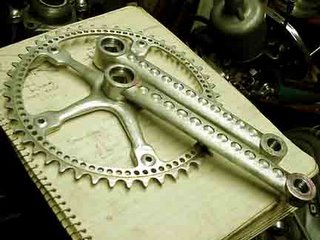
So you wanna know more about dropping a little more weight on your Cyclocross bike? The following are some basic principles for doing just that.
There's a phrase that goes "penny wise and pound foolish." I think it could be changed to "gram wise and kilogram foolish" for the weight "weenie" subculture. The idea that youre going to shed tons of weight off your bike by drilling holes in your derailleur isn't the most brilliant idea (btw you'll only lose like 3-7 grams, ive done it). The real truth is that yes the grams matter but not if your riding a steel bike where the frame and fork alone add up to 8 pounds. (Steel frame lovers dont attack me, there are a lot of great reasons to ride a steel frame, but lightweight isnt one of them). Youre going to have to examine how much money you have to spend on the purging project, establish a goal for the ideal weight of your bike and then start doing some research on what can be lightened and what the payoff is (in terms of grams).
First off some basics:
1. There's 453.6 grams per pound.
2. The general consensus is to not spend more than $2 per gram to lose weight.
For example, my WoundUp CX carbon fork weighs 592 grams (on the heavy end for "light" carbon cyclocross forks), whereas a stock Aluminum CX fork that came on my Trek X01 was 852 grams (cut at 8.25 inches). That's 260 grams or over a half pound shaved, that's a
lot. The fork cost me $200 used. Anytime your spending less than a dollar a gram, you're doing pretty good. In the beginning of your quest, this will be easier than it is when your bike begins to approach your "goal weight".
If you're really serious about building up a light bike and already have a bike to begin with, one common method is to strip the bike down so every part is lying on the floor and weigh each part with a gram scale. You can purchase these from kitchen stores or office stores. It would be ideal to buy a gram scale with 10 pounds as the max capacity. If you don't want to strip your bike down, at least make a list of all the parts on your bike and then go to Weight Weenies to calculate what that part weighs in reality. Don't rely on manufacturers claimed weights as they are rarely accurate and often much heavier. When you have this list, you'll need to compare your items to what I'd call "dream items". "Dream items" might be way out of your budget, but they show you what an item could weigh at its minimum. You can find these "dream item" weights by looking at some of the bling light bikes on this website. You might not have the money to spend $1000-$2000 for a set of wheels, but by looking at what a pair of Reynolds Stratus DV wheels weigh you can compare your own wheelset to that number.
After you compare your items to the "dream items" it should be slightly obvious which items should be first to be replaced. For example if your wheelset weighs 2500 grams, you might want to drop some coin on a lighter set.
You can determine which components to be putting back on your bike by visiting the Roadbikereview CX forum as well as the Weight Weenies forum. There, you can do a search for the item youre thinking about purchasing and seeing what others have said about it in the past.
Issues to consider are how well it works, durability, customer service of the company selling/producing item etc. In the coming days, I will add articles on site about some specific
components that are lightweight that can be used in the cyclo-cross races. Until then, go ride.
photo courtesy of http://www.velo-retro.com/spivey1.html
No comments:
Post a Comment